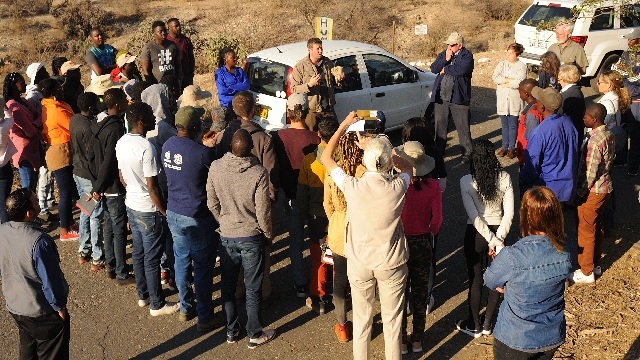
This past week Namibia gained a new weapon in the fight against alien invasive cactus species. These cactus species are some of the worst environmental and agricultural weeds in Namibia. None of the cactus plants in Namibia are indigenous, they were all brought from either North or South America because they are easy to grow and don’t require much attention in one’s garden. Unfortunately, these cactus plants grow far too well in Namibia. They have jumped the fence of the gardens where they were originally planted and are now growing in dense thickets all over the country. This is a serious problem, because indigenous plants and animals are excluded by the cactus and land becomes devalued because the cactus reduces grazing capacity. Wildlife and livestock are also both injured by the spines of the cactus, adding to the problem.
Two of the worst cactus invaders in Windhoek and the surrounding areas are the Devil’s Rope Cactus and The Lady of the Night Cactus . Both form dense and impenetrable thickets in much of the veld surrounding the capital city. NGOs, such as the Cactus Clearing Team, have done a fantastic job manually removing cactus, but today they gained a new weapon to help fight the invaders.
On Friday, 23rd August, the Namibian Chamber of Environment (NCE) and the Botanical Society of Namibia, in collaboration with the Centre for Biological Control (CBC) from Rhodes University, South Africa, released biological control agents to combat both of these invasives. Biological control agents are host specific natural enemies of the cactus that come from the Americas where the cactus is indigenous. In this case, both agents are insects, one is a cochineal insect and the other is a mealybug. They feed on the cactus and slowly kill it, but they can’t feed on any other plant species, so when the cactus dies, the biocontrol agents will die too. Many years of research has been conducted in Australia and South Africa to prove that both these agents are host specific (meaning that they feed specifically on the cactus weed an nothing else). They have both been released in Australia and South Africa for decades, where they have successfully controlled the invasive cactus and have not fed on any other plant species.
The two biological control agents were released at two sites near Windhoek, with the consent of the Ministry of Agriculture, Water and Forestry following an extensive Environmental Impact Assessment. Dr Iain Paterson from the Centre for Biological Control released the agents with a crowd of interested observers, including students from Namibian University of Science and Technology, BotSoc and NCE members. Dr Paterson informed the crowd that ‘We know that these agents are safe and will only kill the cactus, but this process takes a matter of years, not weeks or months, so we must be patient’. Although biocontrol takes time (about 5 years for Devils Rope Cactus) once it has removed the cactus, it will never come back. The cactus will never be completely eradicated, there will always be one or two plants left over. But these will be sites for the agents to live, and whenever the cactus populations start to increase again, the agents will get on top of them.
Biological control is therefore an environmentally safe, effective and sustainable method of controlling cactus weeds in Namibia. These two agents are the first biological control agents to be released in Namibia for over 30 years, so it is a significant step that will hopefully result in other biological control agents for many of the other problematic invasive alien species in the country being considered.
Biological control and the Cactus Clearing Project will continue to work together to control cactus infestations around Windhoek, improving our ecosystems and allowing our indigenous biodiversity to thrive.
